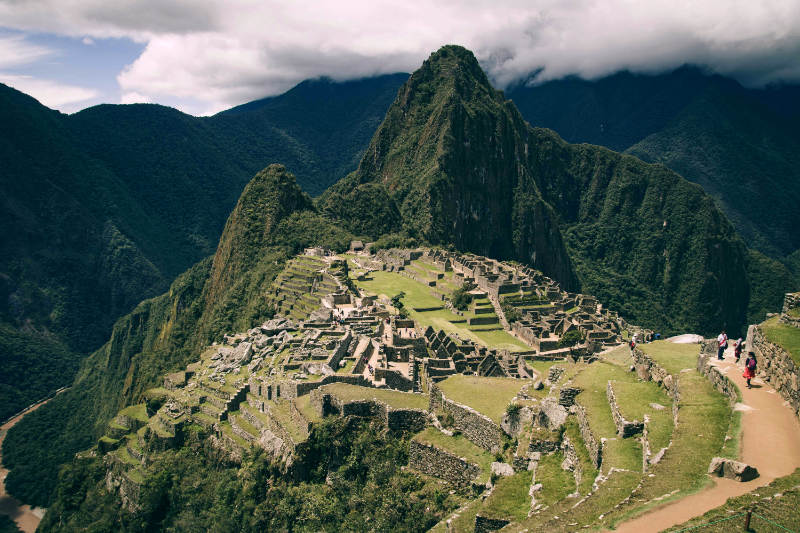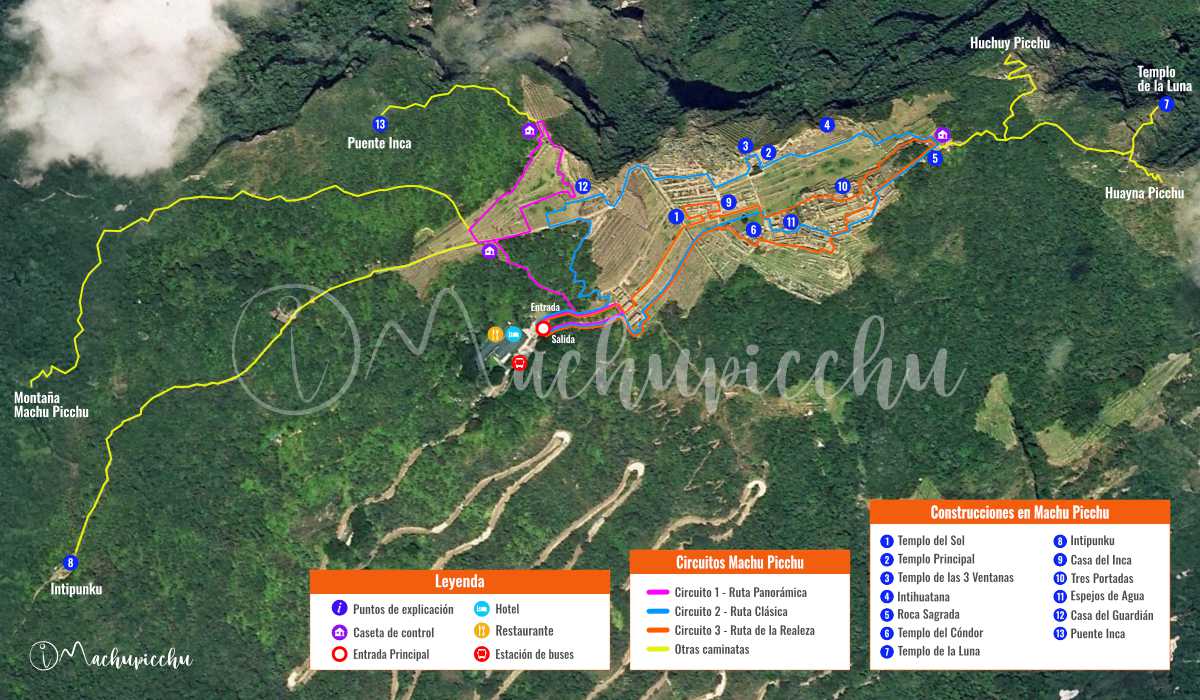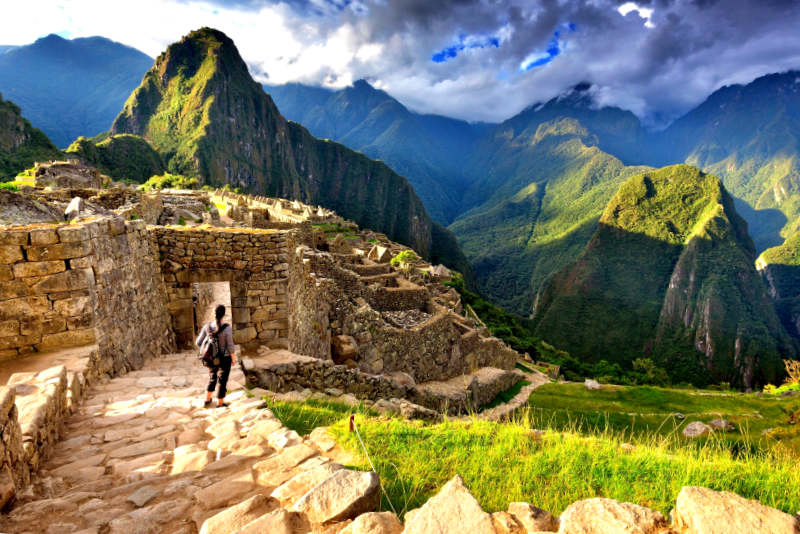Machu Picchu: function of each of its constructions and tempos
Machu Picchu has around 150 stone structures, most of them within its archaeological site, although some of them are located deep or high in its mountains. Today, some of its structures remain closed to the public for preservation and protection; however, most are open to tourists through one of the ten tickets and three circuits. Each temple served a specific function in the citadel, located high on a mountain in the jungle region of Cusco. Learn about its most important sites, how to visit them, and what their function was in Machu Picchu.
- The constructions of Machu Picchu
- The function of each construction in Machu Picchu
- How to visit each temple and building in Machu Picchu?
- Questions and answers about the constructions of Machu Picchu
Machu Picchu Tickets and Tours
There are 10 types of tickets available at Machu Picchu, which are divided into three tour circuits. Each ticket allows you to visit some of the main temples and buildings. The tickets preferred by tourists are: Machu Picchu Classic Designed (Route 2A) and Machu Picchu Classic Lower Terrace (Route 2B). Both allow you to take the second tour of the archaeological site, which includes the most stone buildings, such as the Temple of the Sun, the Main Temple, the Temple of the Three Windows, the Sacred Rock, the Water Mirrors, and more. In addition, the third tour allows you to visit other temples such as the House of the Inca, the Royal Tomb, the Temple of the Condor, and the Sacred Springs. Finally, the first tour allows you to ascend and visit the Guardian’s House and the upper terrace, from where you can take the classic postcard photo of Machu Picchu.
The constructions of Machu Picchu
Machu Picchu has 172 structures, including temples, homes, workshops, plazas, terraces, stairways, viewpoints, and more. Throughout its area, which covers approximately 325.92 square kilometers, we can find urban areas and more isolated sectors next to each of these structures.
Most of its territory is made up of terraces and stone paths (the famous qhapac ñan). While at first glance they appear to be minor buildings, they are actually substantial structures, with several layers of stone and sand underneath for proper drainage in a very humid area.
The most important buildings are in the urban and religious area, now an archaeological site, located above the town of Aguas Calientes at an altitude of 2,430 meters above sea level. There, they built the most important temples dedicated to the worship of Inca gods such as the sun (inti), the mountains (apus), and the earth (pachamama).
The most important buildings at Machu Picchu are made of finely carved granite. The temples dedicated to the sun god feature the finest stonework, including the Temple of the Sun and the Intihuatana. Likewise, other buildings, such as the Sacred Rock and the Temple of the Three Windows, were dedicated to honoring the Inca worldview and religiosity.
The best way to explore Machu Picchu is with a professional tour guide. They are knowledgeable about the function and importance of each of the Inca citadel’s buildings. Furthermore, the temples within Machu Picchu do not have legends summarizing the purpose of each building, so the presence of a guide is essential when touring.
Unfortunately, due to the large number of visitors per day, some structures are closed to the public to prevent future deterioration or damage. The most famous building closed to the public is the Intihuatana, located at the highest point of the religious sector. Access to some trails, such as Huayna Picchu, Huchuy Picchu, the Inca Bridge, and the Great Cave, is also restricted to those over 12 years of age, to protect them from potential accidents. The remaining Inca structures, such as the Temple of the Sun, the Main Temple, the House of the Inca, and the Temple of the Three Windows, are open to visitors.
The function of each construction in Machu Picchu
During your tour of Machu Picchu, according to your ticket’s itinerary, you’ll be able to see most of the archaeological site’s important structures. Learn about their function and importance for a more informed visit:
- The Temple of the Sun – The most important temple in Machu Picchu and the only one with a semicircular shape. Its main function was to serve as a place of worship for the god Inti, the sun, who was the principal deity of the Incas. Its windows were designed with such precision that, during the winter solstice, the sun’s rays entered directly into the interior, marking key dates.
- The Main Temple – Located in the heart of the main plaza, this is the largest structure in the area. With a U-shaped structure and a large central table, this temple was one of the most important, as the most important ceremonies were held there. The highest authorities, along with priests and nobles, met here to make decisions.
- The Temple of the Three Windows – Famous for its size and the perfection of its carving, this site features three large windows strategically oriented to allow sunlight to enter, providing a view of the mountains and the Urubamba River. It is believed that its function was to worship the three deities of the Inca worldview: the celestial world (hanan pacha), the earthly world (kai pacha), and the underworld (uku pacha).
- The Intihuatana – Considered a sundial and astronomical calendar, the Intihuatana (the place where the sun is tied) is an enigmatic stone structure located at the highest point of the religious sector. It features a small, three-tiered pyramid structure that receives the sun’s rays from the top, and whose shadow is projected onto its stone structure. The structure is at a central point from which the sacred mountains were aligned with the cardinal directions, and it was also a place where important activities took place, all of which contributed to its becoming a special center of great energetic charge.
- The Sacred Rock – While there are many other large rocks at Machu Picchu, this one is particularly unique due to its sheer size and its similarity to the contours of one of the mountains in the background. It is believed to have been a place of worship for the snow-capped mountain Pumasillo, from where tributes and offerings were made.
- The Temple of the Condor – This temple, as its name suggests, served as a place of worship for the Andean condor, a sacred animal in the Inca worldview. In Andean culture, condors are believed to be representatives or manifestations of mountain deities. Therefore, they built this structure, which combines stone walls and natural rocks to create the shape of a condor.
- The Temple of the Moon, the Great Cave – Located on the northern slope of Huayna Picchu Mountain, the Temple of the Moon features some of the finest stonework. This cave got its name because the moonlight fills it at night. The Incas considered caves sacred, as it was believed that people came from the mountains through the caves and that souls returned after death to reside there. The Temple of the Moon gained importance due to its association with mountain worship, as well as its opening facing the sunset during the equinoxes.
- Inti Punku – This stone enclosure is at the highest point of Machu Picchu. In Inca times, it was the gateway. Inti Punku means Gate of the Sun, as its structures welcome the first rays of the sun. The views from this spot allow you to experience a different angle of Machu Picchu. It is also the point where hikers on the Inca Trail reach the citadel.
- The House of the Inca – This residence, as its name suggests, served as the home of the Inca or his royal family at Machu Picchu. It features a fine structure with its own access to water, bathrooms, and terraces with viewpoints overlooking the agricultural area. This reflects the privileged status of its occupants.
- Three Gates – This architectural complex is composed of several rooms connected by large doors. This space served as workshops where residents crafted ceramics, textiles, and utensils necessary for life in Machu Picchu. It is located in the urban and agricultural part of the archaeological site, where it also served as a storage facility.
- The Water Mirrors – This room features two carved stone bowls on the floor. It is believed that when the Incas filled the bowls with water, they saw the moon and stars, two of their most important gods, reflected there. It may also have been related to astronomical observations and rituals linked to the agricultural and religious calendar.
- Guardian’s House – Built in a strategic position, high above the residential area of Machu Picchu, the Guardian’s House allowed for surveillance of the agricultural and urban areas. It also served as a place of rest and recreation, given its large area.
- Royal Tomb – This terraced structure atop a tower is believed to have been used as a burial site for the Inca nobility. This site features fine carvings that may represent mountains. The site also features some structures that provide evidence that they were used for offerings, reinforcing its sacred symbolism.
Machu Picchu was built in that geographical area given its relationship with the sacredness they considered the territory, which is why many of its constructions are a symbolic representation of what surrounds this place, such as the mountains (for them they were “Apus”, sacred spirits).
How to visit each temple and building in Machu Picchu?
If you’re planning to visit Machu Picchu and want to know what buildings you’ll see on your tour of the Inca citadel, find out here:
| Main buildings of Machu Picchu | ||
|---|---|---|
| Inca construction | Circuit | Entrance to Machu Picchu |
| The Temple of the Sun |
|
|
| The Main Temple |
|
|
| The Temple of the 3 Windows |
|
|
| The Intihuatana |
|
|
| The Sacred Rock |
|
|
| The Temple of the Condor |
|
|
| The House of the Inca |
|
|
| Three Covers |
|
|
| The Water Mirrors |
|
|
| Guardian’s House |
|
|
| The Royal Tomb |
|
|
| The Temple of the Moon, the Great Cavern |
|
|
| The Inti Punku |
|
|
| Inca Bridge |
|
|
| Machu Picchu Mountain |
|
|
| Huayna Picchu Mountain |
|
|
| Huchuy Picchu Mountain |
|
|
Questions and answers about the constructions of Machu Picchu
1) What was the function of the Temple of the Sun at Machu Picchu?
This temple served as a place of worship to the sun, the god Inti, the most important of the Incas.
2) What was the function of the Temple of the Condor?
This temple was a place of worship for the Andean condor, which connected the earthly world with the world of the gods.
3) What was the function of the Intihuatana?
This Inca pyramid construction was an astronomical calendar that predicted the time of sowing and harvesting in Machu Picchu.
4) What was the function of the Main Temple of Machu Picchu?
It was the temple where the main religious ceremonies in Machu Picchu were held. It has a U-shape.
5) What was the function of the Sacred Rock of Machu Picchu?
This temple is shaped like a mountain. At its base, offerings were made to the tutelary gods, the apus, the highest mountains.
6) What was the function of the Intipunku of Machu Picchu?
This structure at the top of Machu Picchu was the control point for entry and exit to the Inca citadel during Inca times.
7) What was the function of the Guardian’s House of Machu Picchu?
This simple construction was the most complete lookout point in the citadel, a control and surveillance post at Machu Picchu during the Inca Empire.
8) What was the function of the Water Mirrors of Machu Picchu?
This room features two circular formations on the floor where, when water was poured, the stars and the moon, important gods for the Incas, were reflected.
9) What was the function of the Great Cave of Machu Picchu?
This structure was a sacred place where the dead were worshipped. It is believed that the caves connected the earthly world with the world of the dead.
10) What was the function of the Temple of the 3 Windows of Machu Picchu?
This building has three windows that paid homage to the Inca worldview in three worlds: the hanan pacha (upper world), the kai pacha (earthly world) and the uku pacha (underworld).
Advice from people who have been there
 By: Fiorella B.
By: Fiorella B.“The land of the Incas“
“Cusco and Machu Picchu are very old cities with a lot of history where you can breathe tranquility and beauty everywhere. I would come back a thousand times if I could.“
By Ticket Machu Picchu – Last updated, August 15, 2025


